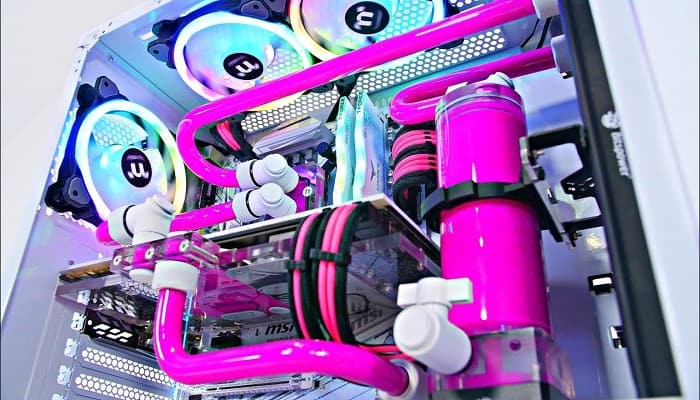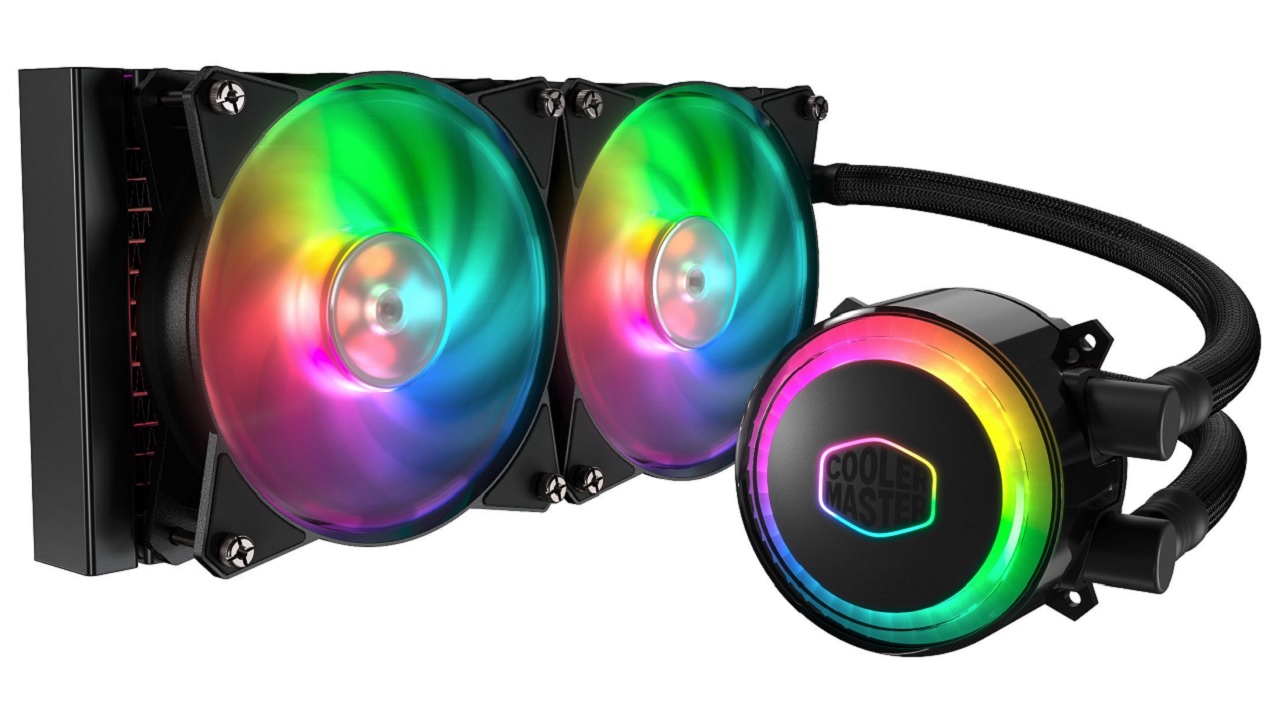In This Article
What is Liquid Cooling?
Liquid cooling is a process which is much similar to the cooling system of a car. This common and very effective process involves circulating distilled water within the system. This helps in removing the heat from the computer rapidly to ensure a better thermal performance.
KEY TAKEAWAYS
- Liquid cooling is one of the best ways to remove heat and eliminate the chances of heat related issues from a computer.
- Liquid cooling is most suitable for long-duration cooling and does not cause any noise pollution since it operates silently.
- Liquid cooling can cool a larger surface area with its more effective coolants and the radiator fan.
- You can choose the easiest All-In-One plug-and-play or a full loop kit or a custom water cooling solution that connects to the graphics card from the processor.
Understanding Liquid Cooling in Computer

Your computer will perform well only when the temperature level is at the desired level. If it crosses that, there are different ways of cooling your computer and liquid cooling is one of these ways.
This method is also known as water cooling.
The best part of liquid cooling is that it is free from noise pollution, apart from removing heat from the most critical areas of modern-day computers.
For most of the computers used in homes and offices, air cooling may be enough to keep the system cool.
However, bigger computers that work for a long duration needs a far better and more effective cooling system. These systems generate excessive heat due to more power consumption. This is where liquid cooling comes handy compared to the air coolers.
This is a silent operator and can cool a huge surface area. Ideally, you can choose from three main types of liquid cooling solutions namely:
- AIO or All-In-One: This is the easiest plug-and-play solution. It comes with all the components in a single pack and is prefilled.
- Full loop kit: You will get all the parts to build this type of liquid cooling solution in the kit.
- Custom water cooling: This system allows you to link it to the graphics card from the processor. The more advanced solutions come with the motherboard within the loop itself.
These cooling systems have coolants. This absorbs the heat and moves to the radiator from the cooling blocks.
The fans in the radiator blow this heat out of the cooling liquid safely.
This is a continual process that keeps the temperatures of the computer within the safe level.
This water removes the extra heat. This is facilitated by the thermal conductivity property and high specific heat capacity of water.
Inside the liquid cooling system, you will find water blocks consisting of the base that connects to the graphics card or the processor and the top that contains the water in the water block safely.
There is also a reservoir that holds the extra coolant that is within the loop. This helps in replacing the air bubbles as the water circulates.
The reservoir can be attached to the pump or can be standalone, depending on the manufacturer.
Then there is a pump attached with the reservoir in the water-cooling system. This pump helps the coolant to circulate inside the loop.
The tubing, also known as the hose, will connect all the parts of the cooling system together and allows a smooth passage of the coolant.
This hose may vary in size because of the variance in fittings. It may also come in different colors and varieties, such as hard or soft tubing.
Fittings are the joints that connect one tubing to the other along with the radiators, water blocks and reservoirs.
The size, shapes and material of the fitting may vary due to the different uses. Therefore, you must make sure that its outer diameter fits with the inner diameter of the tubing.
Finally, there are radiators and fans that cool the hot coolant in the water block down by absorbing the heat from it using the fans that produce static air of high pressure.
You can choose between active and passive liquid cooling systems. The passive systems do not have a fan or water pump.
This reduces the noise levels even further apart from enhancing the reliability of this system, theoretically, but is less effective in dissipating the heat from the computer.
The effectiveness of liquid cooling systems has encouraged the manufacturers to come up with a series of AIO water cooling systems since 2011.
These systems are easy to install and have a lot of positive reviews.
Importance of Liquid Cooling

There are lots of reasons to choose liquid or water cooling for your computer. The most important reason to choose this over air-cooling system is that these systems can control air temperature in a much better and more effective way.
These cooling systems are especially effective on those computers that work under heavy load most of the times and use multiple graphics card and are usually exposed to excessive heat.
- These cooling systems will offer almost endless possibilities for customization. As for most of the cooling systems, you can personalize the loops with more twists and turns in its tubing.
- The simple all-in-one type is easy to use for CPU cooling as you only have to mount and plug them into the motherboard.
Therefore, if you love silent operation, invest in a liquid cooling system, though initially it may seem to be a bit higher due to the additional parts and labor needed.
However, you will enjoy the benefits of it for a long time, justifying the additional cost of it. It is the longer lifespan of the liquid cooling systems that will help you cover the higher cost compared to the others and enable you to save money in the long-term.
Moreover, these cooling systems are especially helpful for the Small Form Factor computer cases that come with space restrictions which makes efficient cooling difficult.
These systems eliminate the need to install big fans and heat sinks that may protrude and interfere with the other components in the case and hinder proper cable management. It is also helpful for those cases where free airflow is not possible for their designs.
The Working Process
The pumps in the liquid cooling system pushes the coolant out of the reservoir and helps it to pass through the loop.
The water then reaches the water blocks and absorbs the heat from the components of the computer. It then travels back to the radiator where it is cooled down. Once cooled, the water follows the same process, over and over again, to absorb more heat.
The process follows the fundamental principle of thermodynamics in physics which states that heat travels from hotter objects to cooler objects.
The tubes, radiator and fins provide a huge surface area ensuring faster cooling. Unlike the common air-cooling systems, liquid cooling for PCs has a more complex mechanism.
This is not a simple plug-and-play variant as the AIO cooling system. Instead it includes:
- A pump to circulate the water
- A reservoir to hold the water
- A radiator and fan for injecting fresh and cool air
- Water blocks to absorb the heat and
- Hoses to connect the components.
In addition to the above basic components, there are also several nuts and bolts to fix the cooling system on your PC.
There is also thermal paste to use so that it improves heat conduction between the chips and water blocks. It is these complexities that add to its cost.
The Pros of Liquid Cooling
1. More effective: When it comes to effectiveness, nothing can match a liquid cooling system. This will prolong the lifespan of your computer hardware.
2. Overclocking: It also has a greater overclocking potential compared to the air coolers which will help you to push the limits of overclocks.
3. Less space: Since real estate is the key, using a liquid cooling system will take less space than the air-cooling system. These are not only small but are also easy to install.
4. Perfect for high temperature zones: If you live or work in an area which is hot most of the time, then these systems will keep the systems much cooler as compared to the air-cooling solutions.
5. Aesthetics: Though subjective, these systems are much more aesthetically pleasing because most of these systems come with attractive RGB lights.
The Cons of It
6. High cost: The higher cost of these systems can be your concern given the fact that you can get high end computer coolers with it.
7. Quality: There are lots of such cooling systems that are of inferior quality, which, when used, can kill all the internal components of the system due to leaks or cracks.
8. Maintenance: These systems require proper care and maintenance, without which, it may lead to some issues.
9. Design: The design of these cooling systems can also bother you which is why you should have a very clear understanding about the dimensions of the chips and components inside the computer including the chip and motherboard so that it fits perfectly within the case.
10. Installation: This is another downside of these coolers because it is not easy, especially for a beginner. You will also need to know the exact space required for its installation.
Questions & Answers:
Do you need liquid cooling for your PC?
Yes, because it will keep your computer cool much more effectively than the air-cooling system. It will also be a much quieter option in comparison.
Is a liquid cooling GPU worth it?
Once again, yes. The technological advances and energy efficiency ensure faster RAM to the GPUs. It will minimize huge voltage draws and clock speeds. This means there will be far less heat wasted.
Is liquid cooling better than fans?
Of course, yes. This is not only due to its higher efficiency but also because this will operate silently. This will provide a better user experience while gaming.
Summary
A liquid cooling system for a computer is a much safer and more effective option, without any doubt. However, the choice is entirely yours and depends on the workloads and performance you expect.